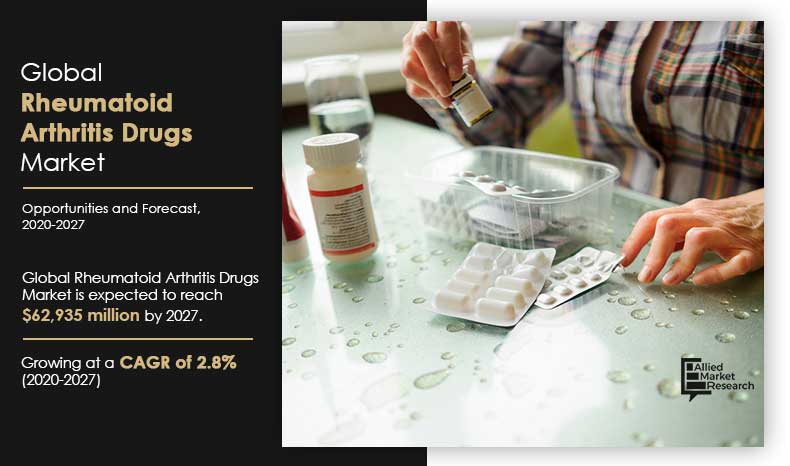
Rheumatoid Arthritis Drugs Market: Trends, Opportunities, and Challenges

Rheumatoid Arthritis Drugs Market Size--
PORTLAND, OR, UNITED STATES, February 3, 2025 /EINPresswire.com/ -- The global rheumatoid arthritis (RA) drugs market is experiencing steady growth, driven by various factors including the increasing prevalence of the disease, advancements in treatment options, and a growing geriatric population. As of 2019, the market was valued at approximately $57.9 billion and is projected to reach about $62.9 billion by 2027, with a compound annual growth rate (CAGR) of 2.8% from 2020 to 2027. This article delves into the dynamics shaping the market, its segmentation, and the opportunities and challenges that lie ahead.
Get a Sample Copy of this Report: https://www.alliedmarketresearch.com/request-sample/3753
Understanding Rheumatoid Arthritis
Rheumatoid arthritis is a chronic autoimmune disorder that primarily affects joints, leading to pain, stiffness, swelling, and tenderness. Unlike osteoarthritis, which is due to wear and tear, RA results from the immune system attacking healthy joint tissues. Although it can affect individuals of all ages, the elderly are particularly vulnerable. While there is no cure for RA, various medications are available to manage symptoms and slow disease progression.
Key Characteristics of Rheumatoid Arthritis:
• Chronic autoimmune disorder affecting joints
• Symptoms include pain, stiffness, and swelling
• No cure available; treatment focuses on symptom management
Key Drivers of the Rheumatoid Arthritis Drugs Market
Several factors are propelling the growth of the RA drugs market:
• Rising Prevalence: Increased incidence of RA globally due to sedentary lifestyles, obesity, and genetic predispositions.
• Aging Population: The geriatric demographic is more susceptible to RA, driving demand for effective treatments.
• Advancements in Biologics: Innovations in biologic DMARDs (disease-modifying anti-rheumatic drugs) have led to more targeted therapies.
• Government Initiatives: Increased awareness campaigns and efforts to improve access to treatments are boosting market growth.
• Expanding Healthcare Access: Improved healthcare infrastructure in developing regions enhances patient access to treatments.
Market Segmentation
The rheumatoid arthritis drugs market can be segmented based on drug class, route of administration, sales channel, and region.
By Drug Class:
• DMARDs: Largest revenue contributor; used as first-line treatment.
• NSAIDs: Commonly used for pain relief.
• Corticosteroids: Provide quick relief but are typically for short-term use.
• Uric Acid Drugs: Manage gout associated with RA.
By Route of Administration:
• Oral: Most common due to convenience.
• Parenteral: Includes injections for biologic DMARDs.
By Sales Channel:
• Prescription-Based Drugs: Dominates due to dosing accuracy.
• Over-the-Counter (OTC): Expected rapid growth due to accessibility.
By Region:
Region Market Characteristics
North America Leads in market share; high healthcare spending
Europe Significant growth due to awareness and support
Asia-Pacific Emerging market with rapid growth potential
LAMEA Steady growth with improving healthcare infrastructure
Opportunities in the Market
The RA drugs market presents several opportunities:
• Asia-Pacific Potential: With a large population and increasing healthcare investments.
• Biosimilars Growth: Expiration of patents for biologic drugs opens avenues for more affordable options.
• Early Diagnosis and Treatment Awareness: Rising awareness drives demand for early intervention.
• R&D Innovations: Continued research into advanced biologics and personalized medicine holds promise for more effective treatments.
Challenges Facing the Market
Despite its growth prospects, the RA drugs market faces challenges:
• High Costs of Biologic Therapies: Expensive treatments limit accessibility in low-income regions.
• Side Effects: Adverse effects like increased infection risk can deter patients from treatment adherence.
• Regulatory Hurdles: Stringent approval processes can delay new drug introductions.
Key Players in the Market
The competitive landscape includes major players focusing on innovation and strategic collaborations:
• AbbVie Inc.
• Amgen Inc.
• Bristol-Myers Squibb Company
• Eli Lilly and Company
• F. Hoffmann-La Roche Ltd
• Johnson & Johnson
• Merck & Co., Inc.
• Novartis AG
• Pfizer Inc.
• UCB S.A.
Future Outlook
The rheumatoid arthritis drugs market is set for steady growth fueled by advancements in treatment options, heightened awareness, and improved healthcare access. Addressing challenges like high costs and side effects will be crucial for sustained expansion. Stakeholders must prioritize innovation and affordability to meet the increasing demand for effective RA treatments.
Key Takeaways:
• Projected market value of $62.9 billion by 2027.
• DMARDs remain dominant; OTC drugs expected rapid growth.
• Asia-Pacific offers significant expansion opportunities.
• High costs and side effects are major challenges.
• Innovations in biologics and biosimilars will shape future treatments.
By navigating these dynamics effectively, the rheumatoid arthritis drugs market can continue evolving, offering hope and improved quality of life for millions affected by this condition worldwide.
Enquire Before Buying: https://www.alliedmarketresearch.com/purchase-enquiry/3753
David Correa
Allied Market Research
+ + 1 800-792-5285
email us here
Visit us on social media:
Facebook
X
LinkedIn
YouTube
Distribution channels: Business & Economy, Healthcare & Pharmaceuticals Industry
Legal Disclaimer:
EIN Presswire provides this news content "as is" without warranty of any kind. We do not accept any responsibility or liability for the accuracy, content, images, videos, licenses, completeness, legality, or reliability of the information contained in this article. If you have any complaints or copyright issues related to this article, kindly contact the author above.
Submit your press release